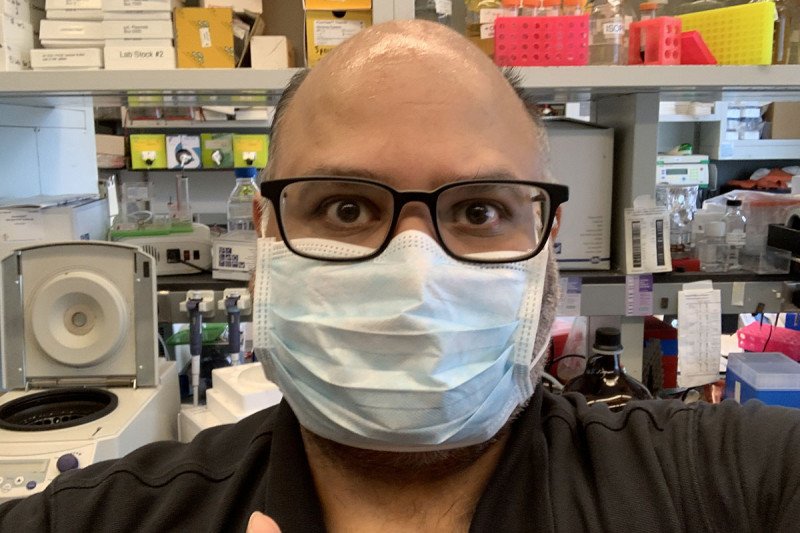
This story was published on June 5, 2020.
On May 18, Sloan Kettering Institute molecular biologist Prasad Jallepalli tweeted, “Today was the first day in which my lab re-opened after a nine week pause, which allowed my clinical colleagues @sloan_kettering and across NYC to deal with the COVID-19 surge. Thanks to their efforts, we can get back to work fighting cancer and other diseases with our brains and our hands.”
In mid-March, as the COVID-19 pandemic was intensifying, Memorial Sloan Kettering leadership made the decision to close labs across the institution that were not directly related to patient care. This was done to protect employees and slow the spread of infection.
As Dr. Jallepalli’s lab and other research labs across MSK began to reopen in late May, we spoke with him about his work during the shutdown and his feelings about reopening.
How did you feel on your first day back?
It was emotional driving in and seeing New York City again; it was very quiet and kind of frozen in time. But at the same time, I felt very excited to go back to doing what I do and making progress on all of my research projects.
It reminded me of when I first started my lab almost 20 years ago. It was a different circumstance, but I had the same feeling: This room needs to be filled with science.
It’s been great seeing everyone smiling under their masks. People are coming in and looking through their notebooks. They’re starting to wake up their cell cultures and plan experiments. Overall, I have a real sense of optimism.
How did you go about shutting down your lab back in March?
Like everyone, I was watching the news and seeing what was happening with the virus. Because of my clinical background, I had my eyes wide open to the fact that what was coming was going to be bigger than anything any of us had ever seen.
Even before the decision to shut down the labs was announced, I was telling people to get their experiments to appropriate pause points. We started freezing cell lines and making backups of important data. We made sure that everyone could access the lab server from home as well as online journals through MSK’s library.
At the same time, I told everyone in my lab that my biggest priority was their safety and well-being. I understood that everyone had different circumstances. They may have young children at home or may be living with an older relative who is at risk. I made it clear that business as usual wasn’t going to happen, and it wasn’t expected.
How did you stay in touch with your team during the lab pause?
It was challenging without the physical presence of the lab, but it was very important to me to maintain the feeling of connectedness.
We did our regular group meetings and journal clubs using Zoom. The overarching purpose was to stay engaged with each other, both intellectually and socially. It’s called social distancing, but it really should be called physical distancing. I didn’t want people to feel socially isolated or like they were adrift.
What did you work on during the lab pause?
Being absent from the lab does limit your capabilities, but we prioritized things we could do from home. I focused on analyzing data, applying for grants, and writing and revising research papers.
Now that you’re back, how will lab practices change?
The task of reopening my lab means getting everyone back into the workplace while keeping them healthy. We’ve gotten really good guidance from our clinical colleagues, especially MSK’s infectious diseases team, in terms of the steps we need to take. They never stopped seeing patients during the time the rest of us were out, and they were implementing all these practices.
We started at about 25% capacity and will gradually go up from there. Areas that normally hold three or four people started with only one person at a time. Now they are limited to two people for a while. Because there will be fewer people working at the same time, we’ll need to implement shifts. Everyone will wear a mask and lab coat and stay six feet apart. We’ll wash our hands and disinfect our equipment frequently.
What are you most excited about in terms of getting back to your research?
For the past several years, I haven’t been spending much time actually doing experiments in the lab. But in January of this year, I decided that I wanted to get back to it. I was eager to work on several new projects related to cancer biology and genetics. When we had to close the lab, it was hard to put that on pause. But since I’ve been back, I’ve had a lot of fun. I can already see my research progressing again.
Helping and mentoring the other people in my lab is also important so they can move forward with their own projects. Overall, everyone has a renewed sense of purpose. We’re all thinking about how we can use science to have a positive impact on the world and on people’s lives.
Besides working, what did you do during the pause?
I was with my family at our home in southern Westchester County. I did a lot of cooking for them. I have a wood smoker, and I made barbecue. There are a lot of similarities between cooking and science: You start with raw materials, and you have ideas about how you want to turn them into a finished product.
But as much as I enjoy cooking, it’s not my profession. My family has noticed how much happier I’ve been since I’ve been able to get back to my laboratory.
— Julie Grisham

